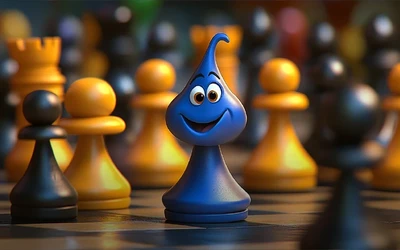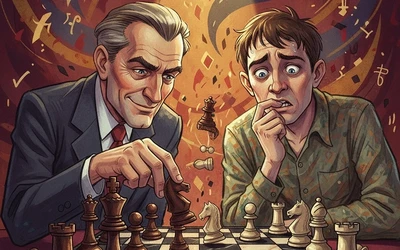
The Presence of Mind in Chess
The real blunders begin when we stop seeing the board — and start living in our heads.We study openings, tactics, and endgames — but rarely study the mind that plays them. Every blunder, every miscalculation, begins with a moment of lost awareness. This post explores what happens when we lose our presence at the board — and how to regain it.
We go through life trying to do our best. In every training session and analysis, we work diligently to produce the highest-quality product possible. And yet, for all we do, sometimes things don't work out. I had a great lesson with my GM coach the day before. Previously, I had written a beautiful post about dynamics and statics, hoping it would reach the same lofty standards as my Naroditsky post. It didn't.
That disappointment carried into my training. I couldn't calculate as clearly or play with my usual confidence. Finally, I stopped forcing it and decided to take a moment to reflect. That's when it hit me.
Table of Contents
What is Presence of Mind?
1. Automatic Moves
2. Tunnel Vision
3. Emotional Tilt
4. Final Thoughts
What Is Presence of Mind?
Realizing that I needed a motivational spark to light my fuse, I decided to pull out an old friend of mine, the Chessmaster Grandmaster software, and went straight for Josh Waitzkin’s Chess Academy. As I listened to him discuss the psychological aspects of chess, I felt something that ran deep within me. He described presence of mind as that rare state where athletes see the basket as wide as a lake, or time itself seems to slow. Unlike philosophers who frame it as distant or transcendent, Waitzkin taught that presence is found in simple awareness—in noticing where you are. For me, that meant taking a breath, walking around, sipping water, and reflecting on the mistakes that pull us away from that state. As we continue throughout the blog post, here are my reflections on the types of errors we can make as chess players when we lack the presence of mind.
1. Automatic Moves
For those blitzers out there, this experience has certainly happened to you before (To my Canadian second, I hope you're reading this!). You see a brilliant move, you play it without thinking, only to blunder your queen!
Automatic moves occur when our brain fails to comprehend a situation; it simply reacts to it. Here are some examples for you to consider in your practical games.
I completely missed White’s idea of ...Qb6 on move 17 in this Benoni structure. I thought Rb8 was "normal," so I couldn't see how it could be wrong. But that assumption was the mistake. In positions like these, White's structural edge demands precision — sometimes even a touch of creativity. You'll see the creativity in the next game, although the players, GMs Burke and Matviishen, were unable to channel their inner Tal:
It should be noted that the Nxg7 idea had been a fixture across many of these positions, including Andriasian-Lazavik, European Blitz 2019, and Oleksiyenko-Safarli, French Team Championships 2019. I had been working with Mykhaylo Oleksiyeko at the time of this game, and so, to no one’s surprise, he gleefully wanted to share the time when he punctured a 2600-rated GM in 20 moves with this same idea! Amazed at his level of witchcraft, I wanted to try it out for myself, and this is what happened:
Well, let’s say my GM coach wasn’t too impressed by this one. Darn it.
2. Tunnel Vision
You find an idea that feels brilliant. You chase it for ten moves — and only then notice your queenside is falling apart.
Presence widens your awareness beyond the plan you want to see. Part of my method for working through this issue is to focus primarily on puzzles that require considering your opponents' resources and ideas, and by taking your time, writing down your solutions as you progress. What are you waiting for? Let’s get started!
This one is an all-time classic, but surprisingly, it often goes unnoticed due to the attack Mikhail Tal was able to utilize to blow his opponent off the board. Yet, for all of the attacking brilliance that this game featured, the potential defensive resources black had are perhaps even more important to consider. Seeing your opponents' resources, however, isn't just limited to the first move, as the following examples show:
The position that you just saw was featured in RB Ramesh's fantastic book "Improve Your Chess Calculation." Just like our intro states, this example perfectly fits the bill of finding a seemingly beautiful line that wins, starting with disconnecting the rooks, only to miss the counterplay that occurs against White's king. This subsequent study, also found in the same book, will give you a similar impression:
Wasn’t that fun? I certainly hope you had fun. Don’t celebrate too early, though, because if that puzzle made you applaud, this next puzzle will get you off your feet!
No words. You tired now? I'm guessing you are! Let's move on then to the final idea:
3. Emotional Tilt
You blunder a piece. Anger takes over. You start playing fast, trying to fix it. But you're not fighting the position — you're fighting yourself.
Presence means accepting reality completely, even when it hurts. For this example, I would like you to turn your attention to a very special game that my GM coach, Max Illingworth, played —a game that, unfortunately, did not go his way, but he graciously allowed me to use it for this post. Here is the game with both of our annotations:
Max was so close to pulling off a brilliancy, but sadly, his only claim to fame for this one was getting past move 67. As you can see, however, the presence of mind is not an easy skill. It requires total attention to detail, and even a minor mistake can be fatal.
4. Final Thoughts
As you go through your chess journey and you're losing your presence of mind, consider three things:
1. Proper training can be highly beneficial. Confidence comes from training the right way daily, and once you learn to trust your training, everything becomes unlocked.
2. Don't worry if the journey feels slow or uncertain; it's a natural part of the process. Many "automatic mistakes" appear when we're still finding our footing in a new opening, tactic, or endgame. Patience is part of the process. As you revisit model games and begin to connect their underlying ideas, progress comes quietly — position by position, insight by insight.
3. Do things for love, not for recognition. Once I embraced blogging as my passion, I felt free—writing became my ultimate form of self-expression. It doesn't matter how many likes or views I get; I realize that posting is something I do because I genuinely love giving back to my community.
4. When you lose your way, look back on the moments when the game made sense — when every move felt connected and true. Revisiting those memories can quietly bring you back to center. To close, I'd like to share one of my own:
Thanks so much for reading! Your loyalty and viewership mean a great deal to me, as I continue to share beautiful chess positions and insights with a community that truly benefits from them. Thanks again to my GM coach @Craze for helping me out on several key portions of my blog post, and who, daily, helps me find my own "presence of mind."
You may also like
 NM UncleRogerJr
NM UncleRogerJrUsing Adversity — The Hidden Power of Resilience in Chess
A journey through the art of counterattacking — revealing how resilience shapes both chess and life. NM UncleRogerJr
NM UncleRogerJrTightening the Lasso: The Real Danger of Facing Lower-Rated Opponents
“You can’t just crush these guys like a bug anymore. You gotta... give ’em some rope.” RuyLopez1000
RuyLopez1000What Will Become of Humanity?
Take a front row seat as you watch your Chess Heroes get ripped apart by Engines. NM UncleRogerJr
NM UncleRogerJrThe Wild Ride of Opposite Sides Castling Positions!
Buckle your seatbelts, and prepare yourself for a fun adventure into the jungle of complications! GM Avetik_ChessMood
GM Avetik_ChessMood10 Things to Give Up to Enjoy Chess Fully
Discover how embracing a lighter mindset can help you enjoy chess again and achieve better results. FM MattyDPerrine
FM MattyDPerrine